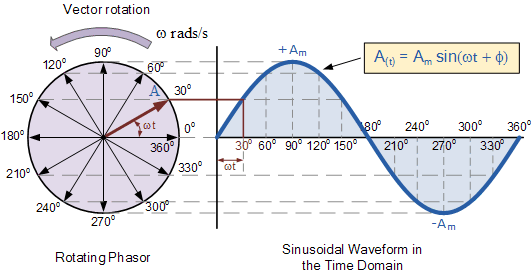Unlocking the Secrets of Phasor Diagrams: A Holistic Guide
Ever feel like you're staring into a cryptic puzzle when faced with a phasor diagram? These enigmatic visualizations can seem daunting, but they hold the key to understanding the dynamic world of AC circuits. Imagine harnessing the power to decode these diagrams, effortlessly deciphering the relationships between voltage, current, and impedance. This journey into the realm of phasor diagrams promises to illuminate the secrets of electrical engineering, empowering you to navigate complex circuit analysis with confidence and grace.
Phasor diagrams provide a visual representation of sinusoidal quantities, like voltage and current, in AC circuits. Instead of grappling with complex trigonometric functions, these diagrams transform the analysis into a geometric exercise. By representing these quantities as rotating vectors, or phasors, we can easily grasp their magnitude and phase relationships. Understanding these diagrams is fundamental for anyone working with AC circuits, from designing power systems to troubleshooting electronic devices.
The concept of phasor diagrams emerged from the need to simplify the analysis of AC circuits. Charles Proteus Steinmetz, a pioneering electrical engineer, is often credited with popularizing the use of phasors in the late 19th century. Before phasor diagrams, analyzing AC circuits involved cumbersome trigonometric calculations. Phasors revolutionized the field, providing an intuitive visual tool to represent these complex relationships.
One of the main challenges in interpreting phasor diagrams is understanding the concept of phase difference. The phase difference represents the time shift between two sinusoidal quantities. This shift is visualized as an angular separation between the phasors. Mastering this concept is crucial for analyzing circuit behavior, particularly in circuits with reactive components like capacitors and inductors.
To understand phasor diagrams, imagine each sinusoidal quantity as a rotating vector. The length of the vector represents the magnitude of the quantity, while the angle it makes with the horizontal axis represents its phase. The direction of rotation is typically counterclockwise, representing the increasing phase angle with time. A simple example is a resistor-inductor circuit, where the current phasor lags behind the voltage phasor.
One benefit of using phasor diagrams is simplifying complex AC circuit analysis. By representing voltages and currents as vectors, we can use vector addition and subtraction to determine the overall circuit behavior. This visual approach simplifies calculations compared to traditional trigonometric methods. Another advantage is visualizing phase relationships between different quantities in the circuit. This visualization helps understand the impact of reactive components on circuit behavior. Finally, phasor diagrams aid in circuit design and optimization, allowing engineers to quickly evaluate the impact of component changes on circuit performance.
To effectively analyze a phasor diagram, start by identifying the reference phasor, typically the voltage source. Then, determine the magnitudes and phase angles of the other phasors relative to the reference. Using vector addition and subtraction, you can then calculate resultant phasors and determine circuit parameters like impedance and power factor.
Advantages and Disadvantages of Using Phasor Diagrams
| Advantages | Disadvantages |
|---|---|
| Simplifies AC circuit analysis | Can be challenging for complex circuits with multiple frequencies |
| Visualizes phase relationships | Requires a good understanding of vector algebra |
| Aids in circuit design and optimization | Doesn't directly represent transient behavior |
Best practices for reading phasor diagrams include understanding the concept of phase difference, correctly identifying the reference phasor, using appropriate scaling for the phasor magnitudes, and being mindful of the direction of rotation. It's also crucial to remember that phasor diagrams represent steady-state conditions and do not capture transient behavior.
A real-world example is analyzing the power flow in a three-phase power system. Phasor diagrams are essential for understanding the phase relationships between the voltages and currents in each phase, enabling engineers to optimize power distribution and minimize losses.
A common challenge is dealing with circuits containing multiple frequencies. Standard phasor diagrams are designed for single-frequency analysis. In such cases, more advanced techniques like Fourier analysis are required.
Frequently asked questions include: What is the difference between a phasor and a vector? How do you represent impedance on a phasor diagram? What is the significance of the angle between two phasors? Understanding these concepts is fundamental to proficiently analyzing phasor diagrams.
A valuable tip is to always start by drawing the reference phasor. This establishes a clear frame of reference and simplifies the subsequent analysis. Remember that practice makes perfect – the more you work with phasor diagrams, the more intuitive they become.
In conclusion, mastering the art of interpreting phasor diagrams unlocks a powerful tool for understanding AC circuits. From simplifying complex calculations to visualizing phase relationships, these diagrams provide invaluable insights into circuit behavior. By embracing these techniques, you empower yourself to analyze, design, and optimize electrical systems with confidence and precision. As you delve deeper into the world of electrical engineering, remember the elegance and efficiency that phasor diagrams bring to the table. Continue exploring, continue practicing, and unlock the full potential of this powerful analytical tool. Embrace the visual language of phasors and embark on a journey of electrical enlightenment. The journey might seem challenging at first, but the rewards of mastering this skill are immense, opening up a deeper understanding of the intricate dance of electrons in AC circuits.

Pin by yannick cougard on Electronique | Kennecott Land

Phasor Diagram Of Rc Series Circuit | Kennecott Land

Phasor Diagram For Inductive Circuit | Kennecott Land

Sinuskurva elektricitet Digitalteknik och elektronik IOT | Kennecott Land

Schneider Electric Phasor Diagram | Kennecott Land

Three Phase Transformer Connections Phasor Diagrams | Kennecott Land

Phasor Diagram Rlc Circuit Parallel | Kennecott Land

Transformer Nameplate Phasor Diagram | Kennecott Land

how to read phasor diagram | Kennecott Land

Phasor Diagram Of Capacitor | Kennecott Land

How To Draw A Phasor Diagram For 3 | Kennecott Land